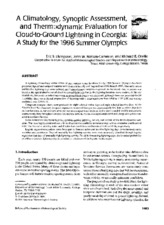| dc.creator | Livingston, Eric | |
| dc.creator | Nielsen-Gammon, John | |
| dc.creator | Orville, Richard | |
| dc.date.accessioned | 2016-10-28T18:31:26Z | |
| dc.date.available | 2016-10-28T18:31:26Z | |
| dc.date.issued | 1996-07-01 | |
| dc.identifier.citation | Livingston, E. S., J. W. Nielsen-Gammon, and R. E. Orville, 1996: A climatology, synoptic assessment, and thermodynamic evaluation for cloud-to-ground lightning in Georgia: A study for the 1996 Summer Olympics. Bull. Amer. Meteor. Soc., 77, 1483-1495. | en |
| dc.identifier.uri | https://hdl.handle.net/1969.1/158216 | |
| dc.description | © Copyright 1996 American Meteorological Society (AMS). Permission to use figures, tables, and brief excerpts from this work in scientific and educational works is hereby granted provided that the source is acknowledged. Any use of material in this work that is determined to be “fair use” under Section 107 of the U.S. Copyright Act September 2010 Page 2 or that satisfies the conditions specified in Section 108 of the U.S. Copyright Act (17 USC §108, as revised by P.L. 94-553) does not require the AMS’s permission. Republication, systematic reproduction, posting in electronic form, such as on a web site or in a searchable database, or other uses of this material, except as exempted by the above statement, requires written permission or a license from the AMS. Additional details are provided in the AMS Copyright Policy, available on the AMS Web site located at (https://www.ametsoc.org/) or from the AMS at 617-227-2425 or copyrights@ametsoc.org. | en |
| dc.description.abstract | A lightning climatology within 50 km of nine outdoor venue locations for the 1996 Summer Olympics has been produced. Spatial and temporal patterns were analyzed for July and August from 1986 through 1993. Unusually active and inactive lightning days were isolated, and thermodynamic variables examined. At the inland sites, no pattern was found in the spatial distribution of cloud-to-ground lightning; that is, the lightning locations were random. At the one coastal site, Savannah, an inland maximum in ground flash density was observed. Although there was great day-to-day variability, there was a diurnal progression of lightning with a broad minimum from 0600 to 1400 UTC and a sharp maximum near 2200 UTC.
Composite synoptic charts were produced for eight selected active days and eight selected inactive days. At the 500-hPa level the composite dewpoint depression in central Georgia was approximately 8°C less on active days than on inactive days. At the 850-hPa level the vector-averaged wind fields on active days revealed weakly anticyclonic southwesterly flow throughout Georgia. On inactive days, the vector-averaged winds exhibited a large anticyclone centered in northern Georgia.
Some correlation was found between cloud-to-ground lightning activity and several of the thermodynamic variables. The most highly correlated was a form of convective available potential energy with a correlation coefficient of 0.70. The Showalter stability index and K index had correlation coefficients of 0.60 and 0.56, respectively.
Logistic regression equations were developed to forecast active and inactive lightning days from thermodynamic variables and persistence. Days of unusually low lightning activity were more accurately identified through logistic regression than days of unusually high lightning activity. To aid in forecasting lightning days, the historical probability of active or inactive lightning days is provided as a function of the logistic model output. | en |
| dc.description.sponsorship | National Science Foundation
National Oceanic and Atmospheric Administration | en |
| dc.language.iso | en_US | |
| dc.publisher | American Meteorological Society | |
| dc.title | A Climatology, Synoptic Assessment, and Thermodynamic Evaluation for Cloud-to-Ground Lightning in Georgia: A study for the 1996 Summer Olympics | en |
| dc.type | Article | en |
| local.department | Atmospheric Sciences | en |
| dc.identifier.doi | 10.1175/1520-0477(1996)077<1483:ACSAAT>2.0.CO;2 | |


